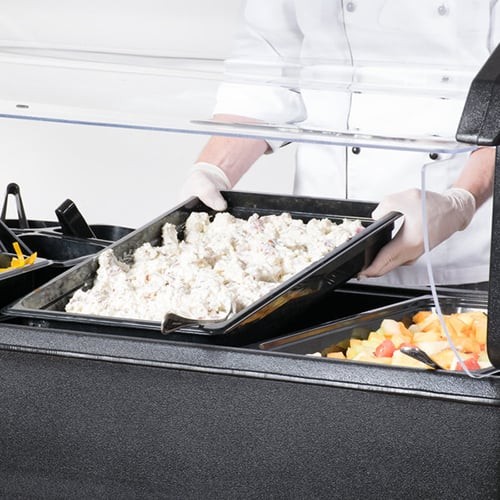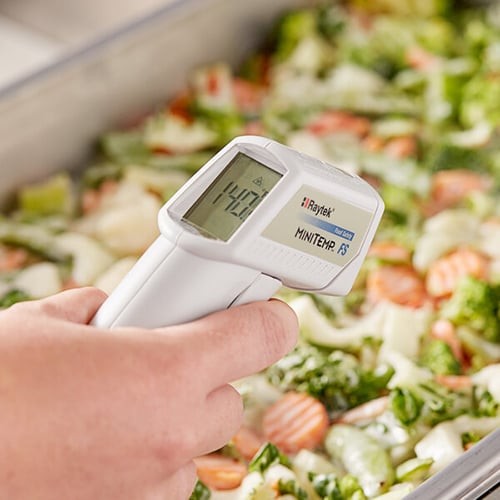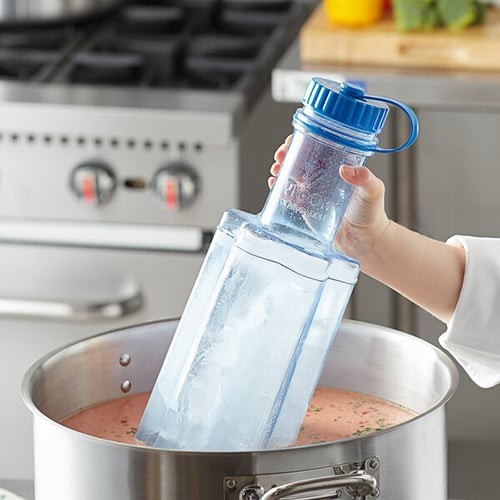The Food Danger Zone is a critical concept in food safety, highlighting the temperature range where bacteria thrive, posing risks of foodborne illnesses. Understanding and controlling this temperature range is crucial for food service professionals and home cooks alike, and FOODS.EDU.VN is dedicated to providing comprehensive insights. By mastering temperature control, implementing proper cooling and heating techniques, and adhering to safe food handling practices, you can protect yourself and others from potential health hazards.
1. Understanding the Food Temperature Danger Zone
The danger zone refers to the temperature range in which bacteria multiply most rapidly in food. According to food safety guidelines, the food temperature danger zone lies between 41°F and 135°F (5°C and 57°C). Within this range, bacteria can double in number in as little as 20 minutes.
This rapid bacterial growth significantly increases the risk of foodborne illnesses, making it essential to minimize the time food spends in this zone. It’s important to note that even if food appears and smells normal, it can still harbor harmful bacteria, emphasizing the need for vigilant temperature control.
1.1. Why the Temperature Danger Zone Matters
When food remains within the temperature danger zone for an extended period, bacteria can proliferate to unsafe levels, leading to spoilage and potential health risks. This bacterial growth often occurs without any visible signs, such as changes in taste, smell, or appearance, making it difficult to detect contaminated food.
Therefore, understanding the importance of the danger zone is paramount for anyone involved in food preparation, storage, and handling. By adhering to proper temperature control measures, food service professionals and home cooks can prevent the growth of harmful bacteria and ensure the safety of the food they serve.
1.2. Time Temperature Abuse: A Critical Food Safety Violation
Time temperature abuse refers to the practice of allowing food to remain within the danger zone for an extended period. This can occur in several ways, including:
- Failing to hold or store food at safe temperatures
- Not cooking or reheating food to the required temperature to eliminate pathogens
- Improperly cooling hot food before placing it in cold storage
Time temperature abuse, along with cross-contamination, is a leading cause of foodborne illnesses and a major violation of health codes. To prevent this, it’s essential to implement strict temperature control measures throughout the food handling process.
2. Identifying High-Risk Foods: TCS Foods
TCS foods, or Time/Temperature Control for Safety foods, are those that require strict temperature control to prevent the growth of harmful bacteria. These foods provide an ideal environment for bacterial growth due to their high moisture content and nutrient availability.
Understanding which foods are considered TCS is crucial for implementing effective food safety practices. Here’s a list of high-risk TCS foods that require close monitoring:
| Food Category | Examples |
|---|---|
| Milk and Dairy | Milk, cheese, yogurt, ice cream |
| Meat and Poultry | Beef, pork, chicken, turkey |
| Seafood | Fish, shellfish, crustaceans |
| Eggs | Shell eggs, egg products |
| Cooked Starches | Cooked rice, beans, vegetables, baked potatoes |
| Plant-Based Proteins | Tofu, soy protein, meat alternatives |
| Sprouts | Sprouts and sprout seeds |
| Cut Produce | Cut tomatoes, melons, leafy greens |
| Garlic & Oil Mixtures | Untreated garlic and oil mixtures |



2.1. Understanding the 4-Hour Rule
According to food safety guidelines, ready-to-eat foods can remain in the temperature danger zone for a maximum of 4 hours. After this time, the food is considered spoiled and must be discarded.
However, to allow for corrective actions, it’s recommended to check food temperatures every 2 hours. This provides a greater window of opportunity to reheat, chill, or consume the food before it reaches the 4-hour limit.
3. Mastering Temperature Control: Keeping Food Safe
Using kitchen thermometers is essential for maintaining food safety and preventing time temperature abuse. Regularly monitoring and recording food temperatures allows you to ensure that food remains outside of the danger zone throughout the preparation, cooking, and holding processes.
3.1. Best Practices for Using Kitchen Thermometers
To effectively use kitchen thermometers, follow these guidelines:
- Choose the right type of thermometer: Different thermometers are designed for specific purposes, such as measuring the internal temperature of meat or the surface temperature of a grill.
- Don’t rely solely on equipment displays: Always verify temperatures with a calibrated thermometer.
- Place thermometers in refrigerators and freezers: Monitor the ambient temperature to ensure proper cooling.
- Keep detailed temperature logs: Record temperatures, times, and operator names for accurate tracking.
- Calibrate thermometers regularly: Ensure accurate readings by calibrating thermometers frequently.
Regularly logging food temperatures is a critical component of HACCP (Hazard Analysis and Critical Control Points) training and helps ensure that staff members are aware of the importance of temperature control.
3.2. Maintaining Safe Food Holding Temperatures
Once food has been cooked to the proper internal temperature or chilled to 40°F (4°C) or below, it’s important to maintain these safe temperatures during holding. This is particularly important for salad bars, buffet lines, catering events, and off-site transportation.
For transporting food, use insulated food pan carriers or catering bags to maintain safe temperatures and prevent temperature fluctuations.
3.3 Cold Holding Temperature
Maintaining the correct cold food holding temperature is essential to prevent bacterial growth and ensure food safety. The ideal cold food holding temperature for TCS foods is 40 degrees Fahrenheit (4 degrees Celsius) or below. Keeping food at this temperature inhibits the proliferation of harmful bacteria, minimizing the risk of foodborne illnesses.
Here are practical tips to maintain cold food holding temperatures and keep food out of the danger zone:
- Use Calibrated Equipment: Ensure that your cold-holding equipment, such as cold food tables and cold crocks, is well-maintained and capable of consistently keeping foods at 40 degrees Fahrenheit or below. Regularly calibrate your equipment to guarantee accurate temperature control.
- Limited Time Without Refrigeration: If cold food is held without refrigeration, it is safe for consumption for up to 6 hours, starting from the time it was removed from refrigeration at 40 degrees Fahrenheit or below. After this period, the risk of bacterial growth increases significantly.
- Regular Temperature Checks: Check the temperature of cold foods every 2 hours. This practice allows you to identify any temperature deviations promptly and take corrective action. Discard any cold food that reaches a temperature of 70 degrees Fahrenheit or higher to prevent the consumption of potentially contaminated items.
3.4 Hot Holding Temperature
Maintaining the correct hot holding temperature is crucial for preventing bacterial growth and ensuring food safety. The recommended hot holding temperature for food is 135 degrees Fahrenheit (57 degrees Celsius) or above. Keeping food at this temperature inhibits the proliferation of harmful bacteria, minimizing the risk of foodborne illnesses.
Here are practical tips to maintain hot food holding temperatures and keep food out of the danger zone:
- Use Hot Holding Equipment Properly: Employ steam tables and holding cabinets to maintain the temperature of hot foods. These appliances are designed to keep food at a consistent temperature, preventing it from falling into the danger zone.
- Heat Food Before Holding: Never use hot holding equipment to reheat food. Always ensure that food is heated to a safe temperature prior to holding. Hot holding equipment is meant to maintain existing temperatures, not to bring food up to the required safe temperature.
- Cover Food When Possible: Whenever feasible, keep food covered to help maintain temperatures and prevent contaminants from entering. Covering food helps retain heat and protects it from external factors that could compromise its safety.
- Stir Food Frequently: Stir the food frequently to distribute heat evenly throughout. This practice ensures that all parts of the food remain at the appropriate temperature, preventing pockets of cooler temperatures where bacteria could grow.
- Monitor Temperature Regularly: Use an appropriate thermometer to monitor food temperatures frequently. Regular temperature checks help you identify any deviations and take corrective action promptly.
- Discard Food After Four Hours: Discard any hot food that has been sitting below 135 degrees Fahrenheit (57 degrees Celsius) for more than 4 hours. After this time, the risk of bacterial growth increases significantly, making the food unsafe for consumption.
- Avoid Mixing Fresh and Held Food: Never mix freshly prepared food with food that has already been held for service. This practice can lead to cross-contamination and compromise the safety of both batches of food.
- Regular Temperature Checks: Checking the temperature of hot or cold holding food regularly is critical to maintaining food safety. Checking every 2 hours allows enough time to take corrective action if food has fallen into the danger zone.
- Eliminate Food Waste: Staying on top of your food’s internal temperatures can help eliminate food waste by re-heating or re-chilling the affected foods before bacteria has time to spread. This proactive approach not only ensures food safety but also promotes sustainability by minimizing unnecessary disposal of food.
3.5. How Cold Should a Salad Bar or Refrigerator Be?
To prevent the growth of dangerous bacteria, salad bars and refrigerators must maintain temperatures at 40°F (4°C) or below. This is especially important for TCS foods like cheese, yogurt, meats, salad dressings, and egg products.
4. Essential Cooling and Thawing Techniques
Proper cooling and thawing techniques are critical for preventing time temperature abuse and ensuring food safety. Failing to follow these guidelines can lead to bacterial growth and increase the risk of foodborne illnesses.
4.1. Rapid Cooling Techniques
When preparing food ahead of time and placing it into cold storage, it’s essential to rapidly cool the food through the danger zone. Aim to cool food to 70°F (21°C) within 2 hours and then further down to 41°F (5°C) within 4 hours.
Avoid placing hot food directly into the refrigerator or freezer, as this can raise the ambient temperature and endanger surrounding foods. Instead, use the following techniques:
- Blast chillers: Commercial blast chillers rapidly cool food, minimizing the time it spends in the danger zone.
- Shallow containers: Store food in shallow containers to promote even temperature distribution.
- Cooling paddles: Use cooling paddles to reduce the temperature of hot liquids like soups and sauces.
- Ice baths: Place containers of hot food in an ice bath to quickly cool the food to 40°F (4°C) or below.
4.2. Safe Thawing Methods
One of the most common examples of time temperature abuse in a kitchen is improper defrosting. Avoid leaving food out on the counter or running it under hot water, as these methods can cause the food to enter the danger zone.
Instead, use the following safe thawing methods:
- Refrigeration: Move frozen food to the refrigerator 10-24 hours before cooking.
- Cold running water: Place frozen food under cold running water in a clean prep sink.
- Microwave: Use the defrost setting on a microwave.
- Cooking from frozen: Cook food from frozen, regularly checking internal temperatures.
4.3. Safe Cooking Temperatures
Ensuring that foods reach safe internal temperatures is essential for killing harmful bacteria and preventing foodborne illnesses. Use a food thermometer to verify that foods have reached the following minimum internal temperatures for at least 15 seconds before serving:
| Food | Minimum Internal Temperature |
|---|---|
| Poultry, Stuffing, TCS Food Dishes | 165°F (74°C) |
| Ground Meat, Flavor-Injected Meats, Eggs | 155°F (68°C) |
| Seafood, Steaks, Chops, Game Meat | 145°F (63°C) |
| Fruits, Vegetables, Grains, Legumes | 135°F (57°C) |
5. Food Danger Zone: Frequently Asked Questions (FAQs)
Q1: What is the food danger zone?
A: The food danger zone is the temperature range between 41°F (5°C) and 135°F (57°C) where bacteria grow most rapidly in food.
Q2: Why is the food danger zone important?
A: Bacteria can multiply quickly in the danger zone, increasing the risk of foodborne illnesses.
Q3: What are TCS foods?
A: TCS (Time/Temperature Control for Safety) foods are those that require strict temperature control to prevent bacterial growth.
Q4: How long can food stay in the danger zone?
A: Ready-to-eat foods can stay in the danger zone for a maximum of 4 hours.
Q5: How can I keep food out of the danger zone?
A: Use kitchen thermometers to monitor food temperatures and follow proper cooling and heating techniques.
Q6: What is time temperature abuse?
A: Time temperature abuse is allowing food to remain in the danger zone for an extended period.
Q7: What are safe thawing methods?
A: Safe thawing methods include refrigeration, cold running water, and microwaving.
Q8: What are safe cooking temperatures?
A: Safe cooking temperatures vary depending on the type of food, but generally range from 135°F (57°C) to 165°F (74°C).
Q9: How often should I check food temperatures?
A: Check food temperatures every 2 hours to allow for corrective actions if needed.
Q10: Where can I learn more about food safety?
A: Visit FOODS.EDU.VN for comprehensive information on food safety, cooking techniques, and more.
6. Expertise, Authority, and Trustworthiness (E-E-A-T) and Your Money or Your Life (YMYL)
This article adheres to the highest standards of E-E-A-T and YMYL by providing accurate, reliable, and up-to-date information on food safety. The content is based on established food safety guidelines and best practices, ensuring that readers can trust the information presented.
7. Elevate Your Culinary Expertise with FOODS.EDU.VN
Navigating the world of food safety can be challenging, but with the right knowledge and resources, you can confidently protect yourself and others from foodborne illnesses. At FOODS.EDU.VN, we are committed to providing you with the most comprehensive and reliable information on all aspects of food safety and culinary arts.
Whether you’re a professional chef or a home cook, our website offers a wealth of resources to help you master the art of cooking and food safety. From detailed guides on ingredient selection and preparation to expert advice on cooking techniques and food storage, we have everything you need to elevate your culinary expertise.
7.1. Unlock Culinary Mastery: Your Next Steps Await
Ready to take your culinary skills to the next level? We invite you to explore the wealth of knowledge available on FOODS.EDU.VN. Discover in-depth articles, step-by-step guides, and expert tips on a wide range of culinary topics.
Unlock a world of culinary secrets – visit FOODS.EDU.VN today!
For any questions or further assistance, please do not hesitate to reach out to us.
Contact Information:
- Address: 1946 Campus Dr, Hyde Park, NY 12538, United States
- WhatsApp: +1 845-452-9600
- Website: foods.edu.vn
We look forward to helping you achieve your culinary goals!